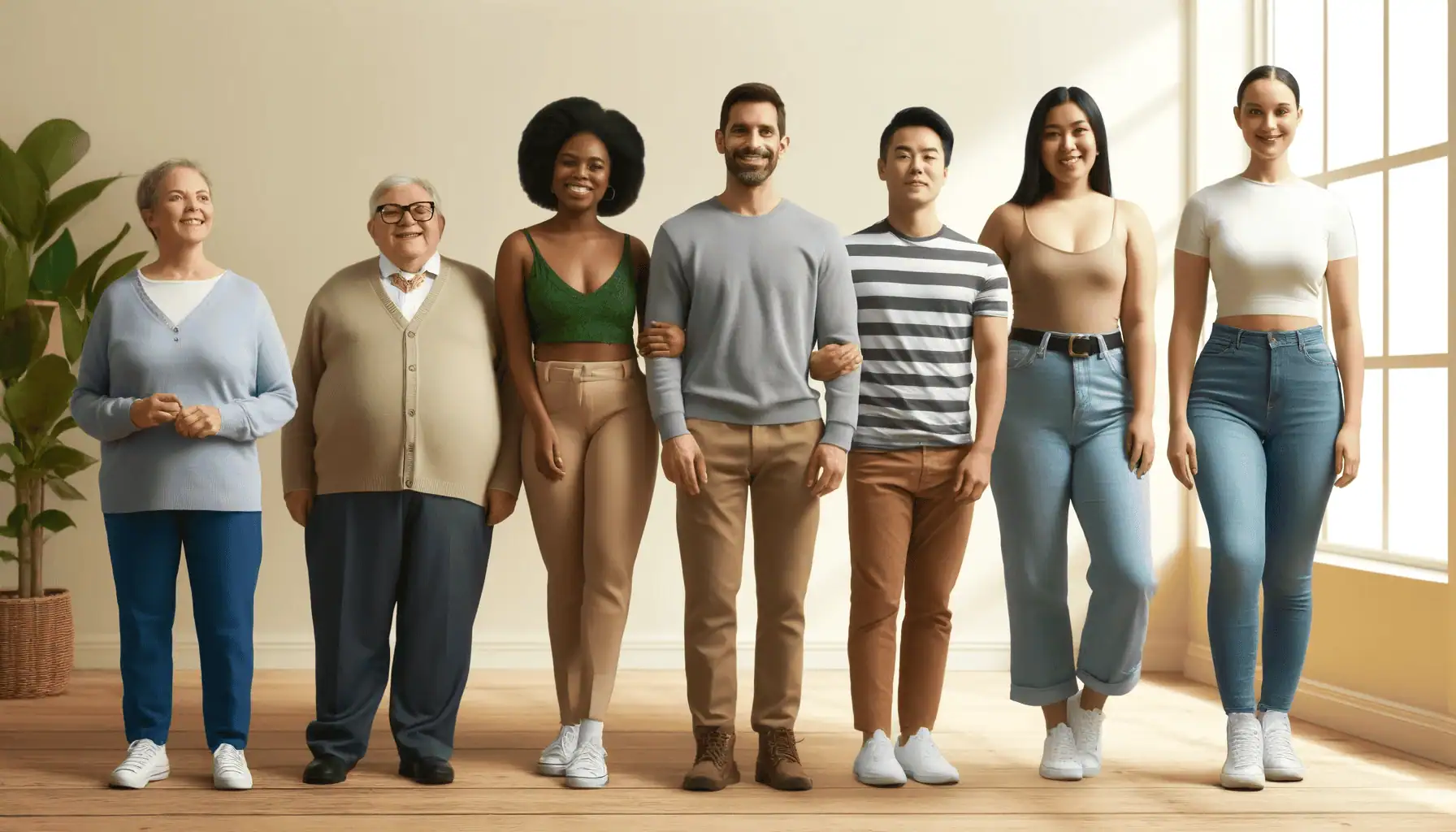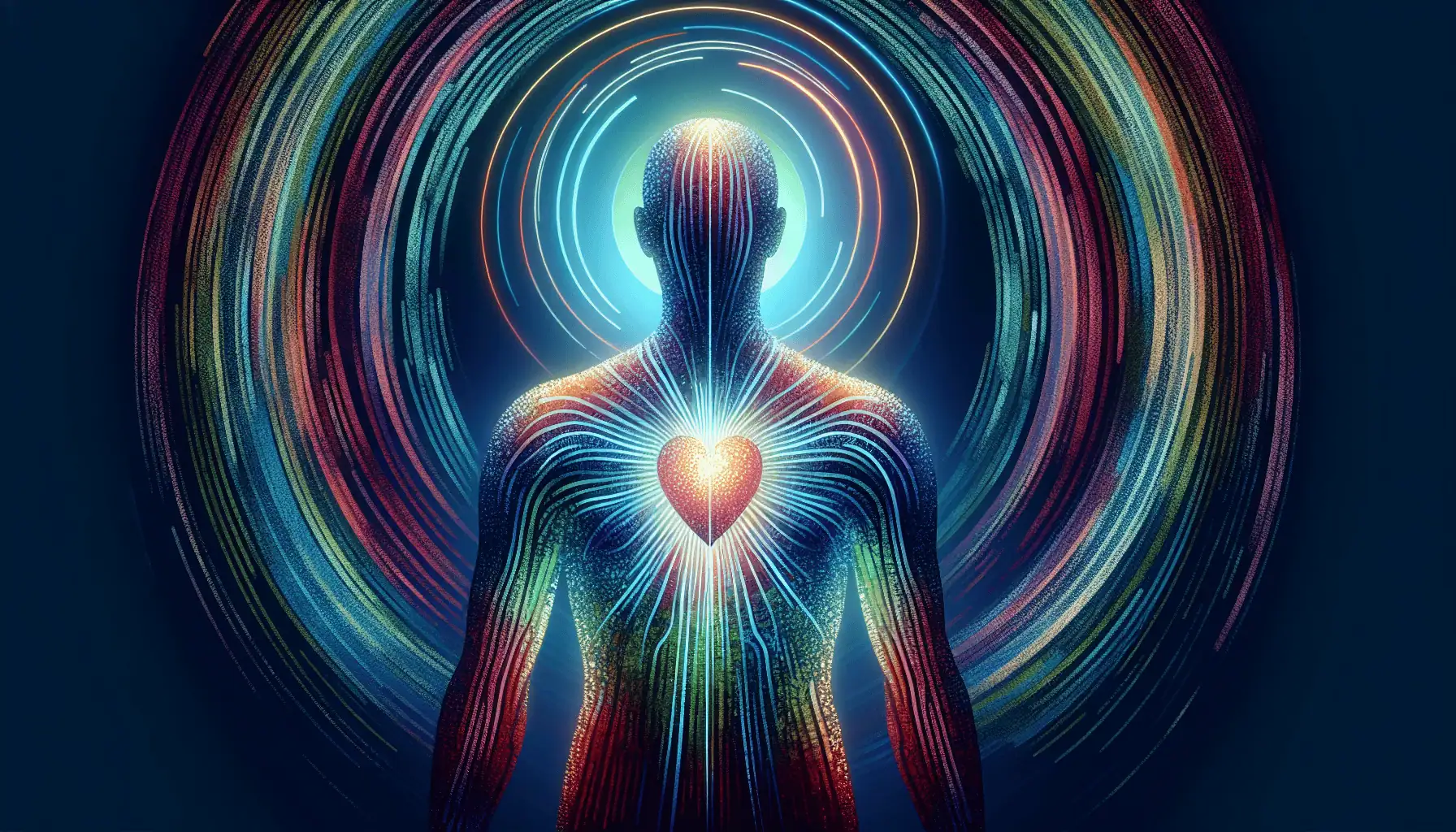
Body Positivity and Its Role in Well-being
In a world inundated with messages about beauty and fitness, body positivity and its role in society stand out as a critical counterbalance. It seeks to build better mental health and more inclusive societies by advocating for the appreciation of all body types, emphasizing the importance of accepting one’s own body. This article digs into its multifaceted influence – its triumphs in weight management and loss and boosting self-esteem, limitations, and practical applications.
Key Takeaways
- The body positivity movement, originating from the 1960s fat rights movement, champions self-acceptance and inclusivity across diverse body types. It aims to dismantle unrealistic beauty standards and encourage self-love.
- Positive body image is crucial for overall well-being, impacting mental health, self-esteem, and social interactions. At the same time, research shows that negative body image can lead to mental health issues and eating disorders.
- Critiques of the body positivity movement include concerns about endorsing unhealthy lifestyles and a lack of inclusivity, leading to calls for a more comprehensive representation of all body types, abilities, and identities.
The Evolution of Body Positivity

The body positivity movement, also known as ‘BoPo,’ traces its origins back to the fat rights movement of the 1960s. It has since evolved into a global initiative promoting self-acceptance and inclusivity. It was born out of a need to challenge the discrimination faced by individuals of higher weights and a desire to criticize the diet industry. As cyberbullying and widespread body shaming on the internet became prevalent, the fat activists and their allies intensified their efforts, giving shape to the modern body positivity movement we know today.
This movement, known as the body positivity movement, emerged in its recognizable form around 2012, alongside a more significant shift in cultural perspectives on beauty and self-acceptance. The movement’s core ethos fosters acceptance and appreciation for all body types, challenging unrealistic beauty standards and encouraging self-love.
From Fat Rights to Inclusive Beauty
The journey from fat rights to inclusive beauty has been challenging. The fat acceptance movement of the 1960s served as the foundation for today’s body positivity movement. A pivotal moment in this journey was the ‘fat-in’ held in Central Park in 1960, coupled with Lew Louderback’s influential article. This event and article contributed significantly to the early defense and acceptance of fatness, setting the stage for a broader campaign for equal rights for people of higher weight.
Organizations like the National Association to Advance Fat Acceptance and groups like the Fat Underground played a crucial role in advocating for rights and confronting weight bias. Moreover, the activism of Black, fat, and queer communities challenged discrimination based on body size, paving the way for a movement that embraces inclusive beauty.
The Impact on Modern Culture
The impact of the body positivity movement on modern culture is evident, especially in social media. Research suggests that exposure to body positivity content on social media platforms may be less harmful to body image than content that idealizes a specific appearance.
This underscores the potential benefit of body positivity content in promoting a healthy body image and self-esteem, as supported by positive body image research.
The Significance of Positive Body Image
Positive self-regulation and body image are more than just feeling good about one’s appearance. It involves recognizing one’s strengths and potential while being realistic about limitations. A positive self-image is vital for overall well-being, impacting mental health, social interactions, and self-esteem. 13% of adults have experienced suicidal thoughts or feelings because of concerns about their body image, highlighting the severe impact of negative body image on mental health.
Embracing body positivity and practicing self-compassion can significantly impact your mental and physical health. These outcomes are closely tied to cultivating a positive body image and can contribute to better physical health. This highlights the benefit of nurturing a healthy body image for holistic well-being. Your self-image influences your interactions with others and has implications for your:
- physical well-being
- mental well-being
- social well-being
- emotional well-being
- spiritual well-being
Combatting Negative Self-Perception
Boosting body image involves more than physical appearance alterations; it necessitates changing thought patterns and reactions to one’s body. Replacing negative thought patterns altered images with realistic ones is a more effective strategy to improve body image than merely covering negative thoughts with positivity.
Cultivating a positive self-image is a dynamic process that necessitates self-inventory and goal setting. Body-positive affirmation statements in visible locations like mirrors and desks can reinforce positive self-perception throughout the day, helping individuals feel more confident and at ease with their bodies.
Research Insights
Research provides valuable insights into the importance of a positive body image. For women’s health, positive body image and appreciation have been linked to greater overall well-being and decreased unhealthy dieting behaviors. On the other hand, body dissatisfaction has been identified as a risk factor for mental health issues, potentially leading to the development of eating disorders.
Engagement measures such as coach message frequency, articles read, and meals logged have shown significant associations with improvements in poor self-esteem, body appreciation, body image flexibility, and even self-compassion without a solid link to losing weight. However, it’s interesting to note that while positive affirmations are often recommended for boosting self-esteem, repeating them can backfire and worsen feelings for people with pre-existing low self-esteem.
Addressing Critiques of Body Positivity
Despite the body positivity movement’s critical role in promoting self-love and acceptance, it has also attracted criticism. There are concerns that the body satisfaction movement may unwittingly endorse unhealthy lifestyle habits and contribute to obesity, leading to a variety of health issues.
Moreover, despite its intentions, the body positivity movement has faced challenges in inclusivity, often excluding:
- older individuals
- people from diverse races
- those with physical disabilities
- gender non-conforming individuals
This exclusion is often due to commercialization.
Health Considerations
One major critique of the body positivity movement revolves around weight stigma and health considerations. Critics expressed concerns that normalizing larger body sizes may encourage sedentary behavior and poor eating habits, potentially leading to health issues. The body satisfaction movement has also been criticized for ignoring the health risks associated with excess body weight and obesity.
Striving for Greater Inclusivity
Inclusivity is another significant area where the body positivity movement has faced criticism. Despite its intentions of promoting acceptance and appreciation of young women of all body types, the movement has been criticized for lacking representation of thin women:
- Black, Indigenous, People of Color
- Fat, plus-sized people
- Disabled individuals
- LGBTQAI+ people
- Aging bodies
- Overall non-normative bodies
This reflects a lack of diversity and inclusivity in body-positive movement, as the visual representation of body positivity tends to favor lean, white, cisgender individuals, neglecting the movement’s diverse origins. There is a growing urgency to reform the body positivity movement to more comprehensively represent individuals across all:
- skin tones
- body sizes
- socioeconomic statuses
- physical abilities
The Intersection of Body Positivity and Mental Health

The connection between body positivity and mental health represents a vital facet of the body positivity movement. Studies have shown that a positive body image is linked to better psychological adjustment and fewer instances of depression, anxiety, and eating disorders. However, exposure to body positivity posts featuring larger women did not necessarily improve an average-sized woman’s mood, highlighting the complexity of the relationship between body positivity and mental health.
Understanding Eating Disorders
Body positivity can play a significant role in understanding and combatting eating disorders. Having a positive body image is a protective factor that can help prevent the development of eating disorders. For those already suffering from eating disorders, body positivity may aid in the alleviation of symptoms by promoting a healthier relationship with one’s body.
Encouraging body acceptance, appreciation, and respect is central to upholding a positive body image and counteracting negative eating behaviors. This highlights the importance of the body positivity movement in promoting mental health, physical activity, and well-being among college students.
Promoting Mental Well-being
Body positivity can significantly influence mental well-being. Research shows that a positive body image is linked to healthy behaviors, better psychological adjustment, and fewer instances of depression, anxiety, and eating disorders. Furthermore, body positivity can improve mood and rewire negative thoughts rooted in dieting behavior, culture, and societal standards.
Over one-third of adults have felt anxious or depressed due to body image concerns. Encouraging self-reflection and restructuring thoughts to feel positive toward self-acceptance can alleviate these negative feelings, reinforcing the importance of nurturing body positivity from a young age.
Body Neutrality as an Alternative
Despite the body positivity movement’s considerable progress in promoting body acceptance and appreciation, its mantra may not resonate with everyone. Body neutrality serves as a viable alternative for those who view body positivity affirmations as inauthentic or overwhelming. Embracing body neutrality means feeling neutral or indifferent about one’s body, shifting the mental spotlight away from the body in weight loss and management.
First mentioned in 2015, body neutrality offers a middle ground that doesn’t force individuals to love or hate their body but to accept it as is. Unlike body positivity, which promotes love and acceptance of the body’s appearance, body neutrality directs attention to the body’s function without emotional attachment. This approach combines the ideas of positivity and body neutrality, creating a balanced perspective on self-image.
What Is Body Neutrality?
Body neutrality is a relatively new concept that focuses on feeling neutral or indifferent about one’s body. It emphasizes acceptance of the body’s functional abilities rather than its appearance, offering an alternative for those who find the affirmations of body positivity to be inauthentic.
While body positivity promotes love and acceptance of the body’s appearance, body neutrality steers attention toward the body’s function without emotional attachment. It advocates for valuing oneself beyond physical appearance, creating a perspective that differs from body- -positivity and body neutrality, which centers on valuing the physical self.
Implementing Body Neutrality Practices
Adopting body neutrality practices requires a focus shift from both negative body image issues and positive body talk to simply existing. This approach involves body-neutral affirmations and countering negative self-talk with neutral phrases.
Moreover, embracing body neutrality also includes intuitive eating, choosing comfortable clothing, and exercising for mental and physical well-being. However, the uptake of this movement in fitness and wellness industries presents a paradox with the focus on body performance and transformation versus accepting bodies as they are.
Real Stories, Real Impact

Personal stories and organizations promoting body positivity in online spaces testify to the profound influence of body shapes and movement. For instance, Iskra Lawrence’s story, shared on The Verywell Mind Podcast, reveals individuals’ journeys to feeling more confident and at ease in their bodies. These real-life stories highlight the transformative potential of the body positivity movement, inspiring others to embrace their bodies as they are.
Organizations like the National Eating Disorder Association and Mirror-Mirror leverage social media to promote messages of:
- love
- acceptance
- advocacy
- positive self-esteem
These initiatives contribute to a cultural shift in how we view body image, fostering a more inclusive and accepting society.
Navigating Social Media and Body Positivity
Social media plays a significant role in promoting body positivity but can also contribute to body dissatisfaction. Platforms like Instagram have helped popularize the body positivity movement but can also contribute to the marginalization of certain body types. Therefore, it’s crucial to recognize the dual role of social media in promoting body positivity and the potential drawbacks.
Curating a Positive Online Space
Creating a positive online space is vital for promoting a healthy body image on social media. This can be achieved by:
- Joining supportive groups
- Following body-positive accounts
- Promoting images that focus on strength and confidence rather than adhering to ‘picture perfect’ standards
- Participating in a No Filter campaign day to encourage authenticity and self-acceptance
- Adding positive affirmations to one’s social media feed
- Posting unfiltered images that reflect genuine enjoyment
These actions contribute to personal body satisfaction and feelings of body appreciation.
Actively challenging cyberbullying related to body size and offering support to victims are essential steps in cultivating a body-positive online environment.
Recognizing and Resisting Diet Culture
Diet culture on social media frequently propagates a thin, fit, ideal body part, commonly masked as health and wellness. Instagram posts using body positivity hashtags often contain fitness-related content, suggesting a skewed representation of what it encompasses. Terms like ‘fitspiration’ and ‘thinspiration’ found on social media platforms contribute to negative body image and can encourage disordered eating behaviors.
To resist diet culture, individuals must critically evaluate social media content and seek representations of diverse body types and beauty standards. This approach promotes a healthier body image and helps resist the negative impact of diet culture on body image.
Summary
Exploring body positivity, we’ve delved into its evolution, significance, critiques, and alternatives. We’ve examined the intersection of increased body image concerns, positivity, and mental and health behaviors and considered body neutrality as an alternative approach. We’ve also heard personal stories of transformation and discussed the role of social media in shaping our perceptions of body image.
The journey towards body acceptance and appreciation is personal and unique to each individual. Whether you resonate with the movement or lean towards body neutrality, the ultimate goal is to foster a healthy relationship with your body, free from societal pressures and unrealistic beauty standards. It’s about embracing self-love and celebrating the diversity of bodies in all their glorious forms.
Frequently Asked Questions
What is the body positivity movement?
The body positivity movement is a social movement that promotes the acceptance and appreciation of all body types, challenges unrealistic beauty standards, and encourages acceptance and self-love.
How can I promote a positive body image?
To promote a positive body image, try changing your thought patterns, setting personal goals, and practicing self-compassion. You can join supportive groups, follow body-positive social media accounts, and post unfiltered images.
What are the critiques of the body positivity movement?
Critics argue that the body positivity movement may endorse unhealthy lifestyle habits and contribute to obesity. Additionally, it faces challenges in inclusivity, often excluding certain groups due to commercialization.
What is body neutrality?
Body neutrality is a concept that emphasizes feeling neutral or indifferent about one’s body. It focuses on the body’s functional abilities rather than appearance, offering an alternative for those who find it inauthentic.
How can I resist diet culture on social media?
You can resist diet culture on social media by critically evaluating the content, seeking diverse body representations, and participating in no-filter campaign days. Adding positive affirmations to your social media feed can also help.

